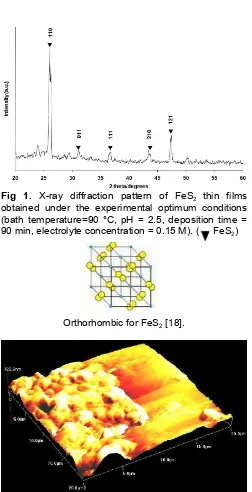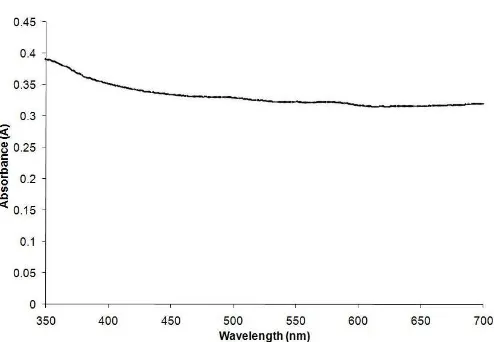Indo. J. Chem., 2010, 10 (1), 8 - 11
Anuar Kassim et al.
8
* Corresponding author. Tel/Fax : +603-89466779 Email address : anuar@science.upm.edu.my
PREPARATION AND CHARACTERIZATION OF IRON SULPHIDE THIN FILMS BY
CHEMICAL BATH DEPOSITION METHOD
Anuar Kassim
1.*, Tan WeeTee
1, Dzulkefly Kuang Abdullah
1, Atan Mohd. Sharif
1, Ho SoonMin
1, Gwee
Siew Yong
1, and Saravanan Nagalingam
21
Department of Chemistry, Faculty of Science, Universiti Putra Malaysia, 43400 Serdang, Selangor, Malaysia
2
Department of Bioscience and Chemistry, Faculty of Engineering and Science, Universiti Tunku Abdul Rahman, 53300 Kuala Lumpur, Malaysia
Received July 1, 2009; Accepted October 1, 2009
ABSTRACT
FeS2thin films have been deposited by using low cost chemical bath deposition technique. The films obtained
under deposition parameters such as bath temperature (90 °C), deposition period (90 min), electrolyte concentration (0.15 M) and pH of the reactive mixture (pH 2.5). The thin films were characterized using X-ray diffraction and atomic force microscopy in order to study the structural and morphological properties. The band gap energy, transition type and absorption properties were determined using UV-Vis Spectrophotometer. X-ray diffraction displayed a pattern consistent with the formation of an orthorhombic structure, with a strong (110) preferred orientation. Atomic force microscopy image showed the substrate surface is well covered with irregular grains. A direct band gap of 1.85 eV was obtained according to optical absorption studies.
Keywords:Iron sulfide, X-ray diffraction, chemical bath deposition, thin films
INTRODUCTION
In search of new semiconducting materials for solar energy conversion through photoelectrochemical cells, metal chalcogenides are increasingly studied. These materials to be potential candidates in solar cells due to band gap energy between 1 to 2 eV. Iron sulphide thin films attract attention of many researchers due to good potential for photovoltaic and photo-electrochemical applications. Iron sulphide thin films consist of abundant and non-toxic elements. The FeS2 thin films have been prepared by a variety of methods such as flash evaporation [1], metal organic chemical vapour deposition [2], vacuum thermal evaporation [3], sputtering [4], chemical vapour deposition [5], electrodeposition [6] and molecular beam deposition [7]. Each technique of thin film deposition has its own advantages and disadvantages. The technique such as chemical bath deposition, which is economical, highly feasible for large area deposition and producing well adherent thin film is of interest to researchers. Chemical bath deposition method is based on the reaction between dissolved iron ions and sulphur-containing organic compound (sodium thiosulfate) in acidic water solution. The triethanolamine was used as complexing agents for depositing iron sulphide thin films. The complexing agent as a component of the chemical bath eliminates spontaneous precipitation by slowing down the release of the metallic ions on dissociation thereby resulting in slow precipitation of the compound. So far,
many semiconductor thin films deposited by chemical bath deposition method have been reported including PbS [8], MnS [9], ZnS [10], CdS [11], SnSe [12],
Cd1-xZnxS [13], CuInSe2[14], Cd1-xZnxSe [15], Cu4SnS4[16] and CuBiS2 [17]. However, there have been no reports in the literature on the aqueous solution deposition of iron sulphide thin films in the presence of TEA as complexing agent. In the present work, the preparation of FeS2 thin films by using chemical bath deposition technique was described. The bath contained iron nitrate, sodium thiosulfate and triethanolamine solutions. The structural and morphological of thin films were investigated by using X-ray diffraction and atomic force microscope, respectively. Meanwhile, the optical properties of FeS2thin films were studied by using UV-Visible Spectrophotometer.
EXPERIMENTAL SECTION
Materials
Indo. J. Chem., 2010, 10 (1), 8 - 11
Anuar Kassim et al.
9
Instrumentation
In order to investigate the crystallographic properties of the FeS2thin films, we carried out the X-ray diffraction (XRD) analysis using Philips PM 11730 diffractometer with CuKα (λ = 1.5418 Å) radiation. The surface morphology and the root mean square (RMS) surface roughness of the films were characterized by using atomic force microscope (Quesant Instrument Corporation, Q-Scope 250). The optical absorption measurement was carried out in the wavelength range from 350 to 700 nm by using a Perkin Elmer UV/Vis Lambda 20 Spectrophotometer. The film-coated glass substrate was placed across the sample radiation pathway while the uncoated glass substrate was put across the reference path. The absorption data were manipulated for the determination of the band gap energy (Eg).
Procedure
For the careful cleaning of microscope glass substrates, the substrates were initially degreased in ethanol for 10 min and then washed with distilled water. These substrates were further treated with ultrasonic waves for 15 min, prior to deposition. In actual experimentation, 20 mL of 0.15 M iron nitrate solution was taken in 100 mL beaker. Then, 10 mL of triethanolamine solution was added in beaker. Following that, 20 mL of 0.15 M sodium thiosulfate solution was mixed in it. By adding drop-wise hydrochloric acid, the pH of the reactive mixture was adjusted to 2.5. The beaker was kept in water bath. The temperature of the bath was then allowed to increases slowly up to 90 °C. The ultrasonically cleaned glass substrates were immersed vertically into acidic bath. After 90 min, the glass slide was removed, washed several times with distilled water, dried naturally in desiccator.
RESULT AND DISCUSSION
Fig. 1 shows a typical X-ray diffraction (XRD) pattern of FeS2 thin films obtained under the experimental optimum conditions (bath temperature = 90 °C, pH = 2.5, deposition time = 90 min, electrolyte concentration = 0.15 M). Peaks corresponding to (110), (011), (111), (210) and (121) planes of FeS2 (JCPDS reference No.: 00-024-0074) were evident and no elemental peaks for Fe and S were observed. According to XRD pattern, the sample shows polycrystalline in nature with preferential orientation along (110) direction and this is orthorhombic [18] structure. The color of the sample is yellowish brown and opaque in nature.
Fig 1. X-ray diffraction pattern of FeS2 thin films obtained under the experimental optimum conditions (bath temperature=90 °C, pH = 2.5, deposition time = 90 min, electrolyte concentration = 0.15 M). ( FeS2)
Orthorhombic for FeS2[18].
Fig 2.Atomic force microscopy image of FeS2thin films obtained under the experimental optimum conditions (bath temperature = 90 °C, pH =2.5, deposition time = 90 min, electrolyte concentration = 0.15 M)
Indo. J. Chem., 2010, 10 (1), 8 - 11
Anuar Kassim et al.
10
Fig 3.Absorbance versus wavelength spectrum of FeS2 thin films obtained under the experimental optimum conditions (bath temperature = 90 °C, pH = 2.5, deposition time = 90 min, electrolyte concentration = 0.15 M)
Fig 4. Plot of (Ah)2 versus h band gap of FeS2 thin films obtained under the experimental optimum conditions (bath temperature = 90 °C, pH = 2.5, deposition time = 90 min, electrolyte concentration = 0.15 M)
is irregular and non uniform. It had also been observed that the thickness and root mean square (RMS) surface roughness were 723 and 72.8 nm, respectively. Such roughness of the film was unavoidable since grains were grown with different sizes and shapes [19].
The optical absorption of iron sulfide thin films in the wavelength range 350-700 nm has been investigated using UV/Vis Lambda 20 Spectrophotometer (Fig. 3). A significant absorption is evident below 450 nm. The absorption edge extended to wavelengths which longer than 700 nm. This indicated the film is active in the visible and infrared region. Thus, there is good possibility that this material can be used as infrared devices and solar cells.
Band gap energy and the transition type can be derived from mathematical treatment of the data obtained from optical absorbance versus wavelength with Stern relationship of near-edge absorption (Equation 1):
whereis the frequency,h is the Planck’s constant, k
equals a constant whilen carries the value of either 1 or 4. The value of n is 1 and 4 for the direct transition and indirect transition, respectively. Fig. 4 shows the plot of(Ah)2/nversus h, which is a straight line in the domain of higher energies, indicating a direct optical transition. The band gap energy is obtained by extrapolating the linear portion of (Ah)2/nversus h to the energy axis at (Ah)2/n = 0. The bandgap energy value of the film was estimated about 1.85 eV from the optical spectrum analyses.
CONCLUSION
The FeS2thin films can be chemically deposited by using iron nitrate, sodium thiosulfate and triethanolamine solutions. The XRD pattern reveals the formation of an orthorhombic structure, with the strongest peaks attributed to (110) plane of FeS2. Atomic force microscopy image showed the substrate surface is well covered with non uniform grains. The band gap of the material was found to be 1.85 eV.
ACKNOWLEDGEMENT
The authors would like to thank the Department of Chemistry, Universiti Putra Malaysia (UPM) for the provision of laboratory facilities.
REFERENCES
1. Ferrer, I.J., Nevskaia, D.M., Heras, C., and Sanchez, C., 1990,Solid State Commun., 74, 913. 2. Hopfner, C., Ellmer, K., Ennaoui, A., Pettenkofer,
C., Fiechter, S., and Tributsch, H., 1995, J. Cryst. Growth,151, 325.
3. Rezig, B., Dahman, H., and Kenzari, M., 1992,
Renewable Energy, 2, 125.
4. Birkholz, M., Lichtenberger, D., Hopfner, C., and Fiechter, S., 1992, Sol. Energy Mater. Sol. Cells,
27, 243.
5. Willeke, G., Blenk, O., Kloc, Ch., and Bucher, E., 1992,J. Alloys Compd., 178, 181.
6. Nakamura, S. and Yamamoto, A., 2001, Sol. Energy Mater. Sol. Cells, 65, 79.
Indo. J. Chem., 2010, 10 (1), 8 - 11
Anuar Kassim et al.
11
8. Larramendi, E.M., Calzadilla, O., Arias, A.G., Hernandez, E., and Garcia, J.R., 2001, Thin Solid Films, 389, 301.
9. Gumus, C., Ulutas, C., and Ufuktepe, Y., 2007,Opt. Mater., 29, 1183.
10. Ubale, A.U., Sangawar, V.S., and Kulkarni, D.K., 2007,Bull. Mater. Sci., 30, 147.
11. Soundeswaran, S., Kumar, O.S., and Dhanasekaran, R., 2004,Mater. Lett., 58, 2381. 12. Zainal, Z., Saravanan, N., Anuar, K., Hussein, M.Z.
and Yunus, W.M.M., 2004,Mater. Sci. Eng., B, 107, 181.
13. Khefacha, Z., Benzarti, Z., Mnari, M., and Dachraoui, M., 2004,J. Cryst. Growth, 260, 400.
14. Bari, R.H., Patil, L.A., Sonawane, S., Mahanubhav, M.D., Patil, V.R., and Khanna, P.K., 2007, Mater. Lett.,61, 2058.
15. Hankare, P.P., Chate, P.A., Asabe, M.R., Delekar, S.D., Mulla, I.S., and Garagkar, K.M., 2006, J. Mater. Sci. - Mater. Electron., 17, 1055.
16. Anuar, K., Tan, W.T., Atan, M.S., Dzulkefly, K.A., Md. Jelas, H., Ho, S.M., and Saravanan, N., 2009,
J. Ultra Chemistry, 5, 21.
17. Sonawane, P.S., Wani, P.A., Patil, L.A., and Seth, T., 2004,Mater. Chem. Phys., 84, 221.
18. Buerger, M.J., 1931,Am. Mineral., 16, 361.

